You probably know lox, gravlaks, gravlax, gravad laks, etc. There are many versions of this, but they all boil down to the same: fish fillet is cured, then sliced thin and served. As a rule, gravlaks is not smoked, and traditionally lox isn’t either. Smoked salmon is a different thing, and I for one find them remarkably different.
Usually this curing process is done with salmon, because it originated around the North Sea where salmon is (or was) very plentiful and used as a staple protein, and because salmon has enough fat and such that it stores very well if processed. Similar products — cured, smoked, and/or dried salmon — are also traditional among many native communities along the Pacific Northwest where Pacific salmon run.
Provided the fish you use is impeccably fresh, you can cure anything, and it’s easy to do at home. You can also cold-smoke at home, but it’s something of a production. I’m thinking of trying that one of these days, too, but I thought I’d start with the easy one.
The only irritating part about making gravlax is that you have to have two pieces which are pretty close to the same size. Of course, that means there’s an easy solution and a hard one. The hard solution is to go find (or cut) two same-sized pieces. The easy solution is to buy a whole fish, since the two fillets will be pretty much identical, assuming it’s not a totally lopsided fish! Fortunately, whole fish is easy to come by in Japan, and if you choose right, it doesn’t need to be expensive.
Meet Larry
I went to Tavelt, which is pretty much the best supermarket in Kyoto. It’s not as comprehensive or as cool as Nishiki Market, but it’s a lot cheaper and carries all kinds of non-traditional ingredients that you can’t find in Nishiki — things like tortillas, capers, cheese, and anything else you pretty much never see in Japanese cuisines.
After looking around quite a bit, I decided on a whole large aji, or horse mackerel. This is one of my favorite fish, excellent sliced raw, grilled, and just about anything else. I figured this was a good choice, because it’s so versatile, and it’s medium-fatty like salmon. It’s also quite easy to fillet, which is nice. To top it off, aji isn’t expensive.
Here’s Larry, soon to be Larry the Lox:
I’m not sure what Larry weighs, because he and his cousins were sold per piece, but I’d estimate a little more than a kilogram. After filleting and such, Larry the Lox should be a little more than a pound. He cost me $6.
Larry Has A Little Accident
Out comes the deba-bōchō — the standard Japanese filleting knife — plus the fish scaler, cavity broom (I have no idea what these are properly called), and the bone tweezers.
First, Larry had his scales removed. Because Larry is an aji, he also has a hard strip of armor in running in front of his tail, and that had to be cut off. Then a cold bath.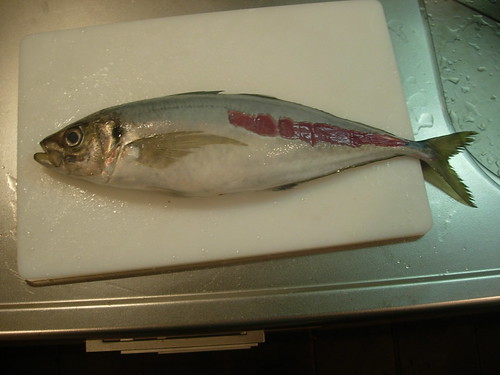
Sorry Larry, off with your head!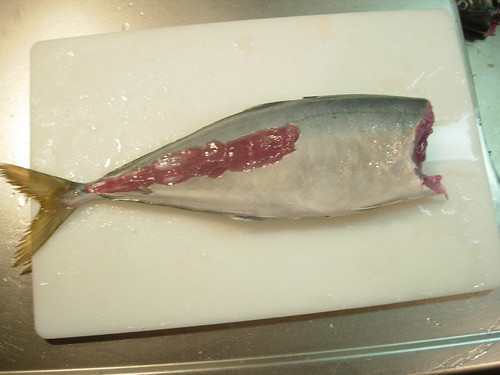
Then out come the guts. A little careful work with the knife, and all the blood was loose and exposed.
Larry had another bath and a thorough scrub with the brush, inside and out, and here he is all clean and tidy.
The first fillet is cut from the cavity side, in three or four strokes: cut up to the backbone, then along the backbone shearing through the pinbones, then up to the dorsal fin, which last can take a couple of strokes, depending. I screwed up a bit with the last stroke, because I didn’t expect Larry’s backbone to be so thick. Oh well.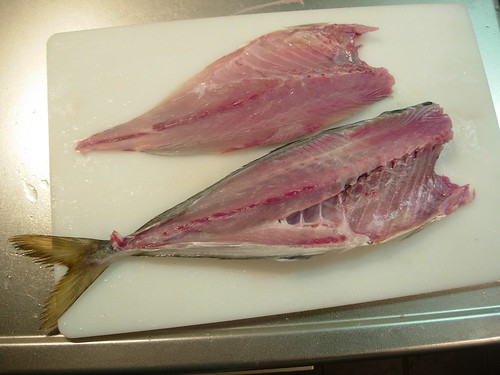
The second fillet is done in reverse. Start at the dorsal side, and cut down to the backbone, then through the pinbones, then down into the cavity and off. Here’s poor old Larry as two fillets, with a couple strips from my screwup down front, and then in the sink you can just see his head and skeleton.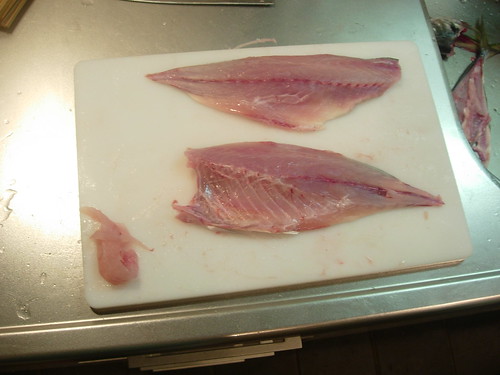
Now the ribcage is still attached to the fillets, so we have to cut those off. Then I run my fingers along the pinbones and pull them out with heavy tweezers. Look how many pinbones he's got!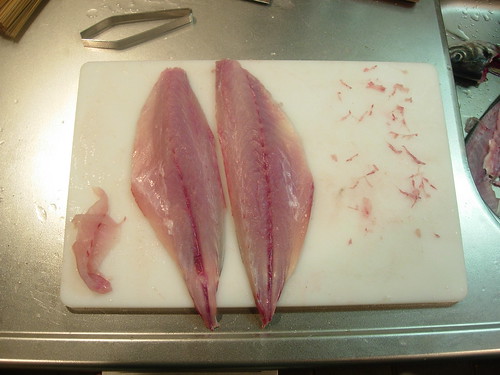
A good wipe-down, both sides, and Larry was all ready to go.
Larry Gets Loxed
Poor Larry deserved a drink after what I’d done to him, so I rubbed a little gin into his flesh.
I’d made up a standard mix of salt, sugar, and black pepper. The proportions seem to vary rather a lot, but I thought I’d go heavy on salt and light on sugar because aji is very sweet. The fillets got a pretty healthy coating.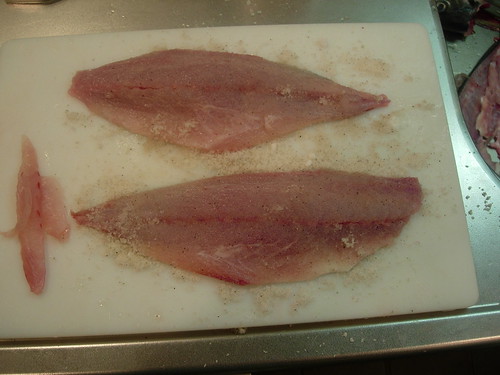
On the flesh side of each fillet, I put fresh sansho, a bunch of dill, and some shiso leaves. Sansho is in season right now, dill is traditional in gravlax, and shiso goes well with aji — I also happened to have some on hand.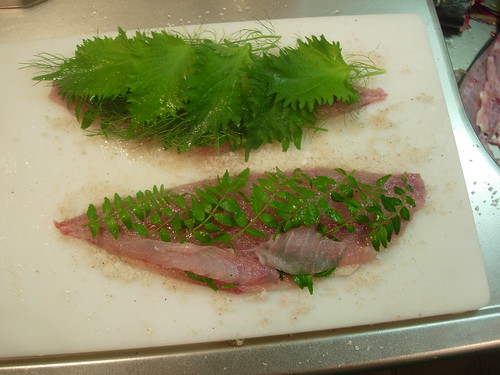
Then the fillets go together with the herbs on the inside.
After coating Larry in lots more salt mixture, I wrapped him tightly in a couple of layers of plastic wrap. This went in a shallow tray, weighted down with a board and shoved in the fridge to cure.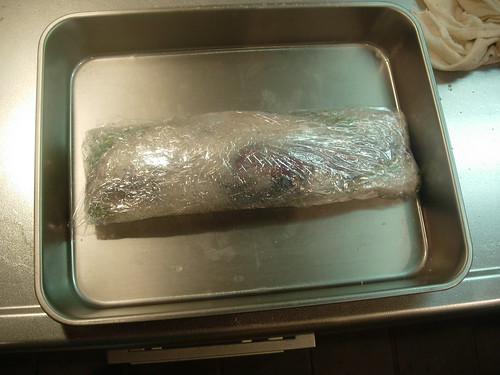
Every twelve hours or so, I took it out, drained off liquid, rewrapped, and put it back in the fridge turned to the other side. After turning twice, I let Larry sit weighted for another day.
Larry came out,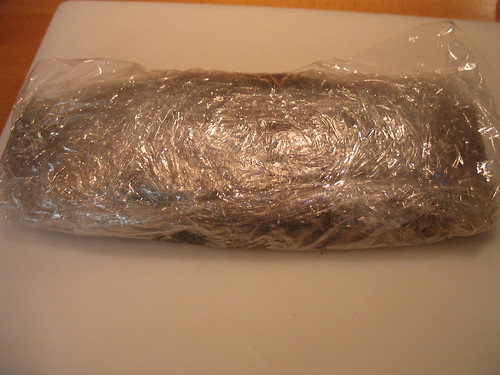
I wiped him down, and here at last is Larry the Lox.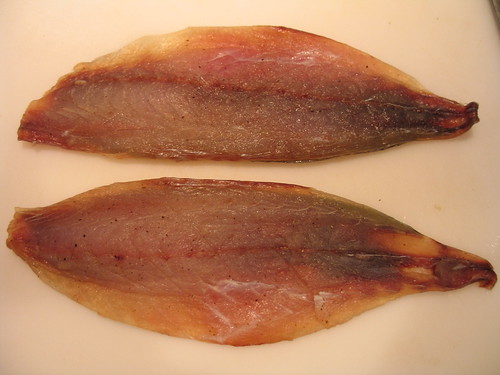
Larry Comes To Dinner
We've tried Larry two ways thus far, but I've only photographed one.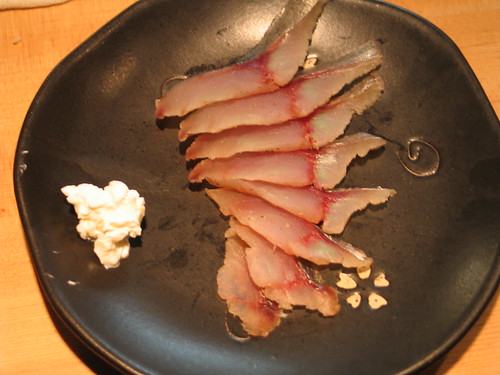
This is Larry the Lox, thinly sliced, presented with a little sour cream. We had this with crusty pain de campagne.
Now I should say that I was rather worried about Larry. Since doing all the preparation work, I happened to see an old Iron Chef episode where horse mackerel (aji) was the theme ingredient. What the judges kept saying was that aji is well known to have a very strong odor, an intense "fishiness". Salmon, of course, is one of the mildest, un-fishy fish around. So I was concerned that maybe this hadn't been the best fish choice, and we'd have something pretty unpleasant in Larry the Lox.
In fact, the main problem is the sansho I put on there. I did that because I happened to have a bunch: it's inexpensive right now, because it's in season. What's more, Japanese cured fish products with sansho are quite common, so I figured it would be a good idea. The only thing is, it's quite intense, and the flavor has definitely been drawn out here by the curing process. The result is that Larry tastes strongly of sansho.
The texture is a bit dense and chewy, but not excessively so. The flavor, beyond the sansho, is really rather nice if you like fish. Larry is a bit fishy, but not in an unpleasant way. In fact, the strong aji flavor stands up well to the sansho. I think Larry might go over rather well here in Japan, but maybe not so much at home in the States, where sansho is not a familiar flavor.
The first tasting, with sour cream and bread, was successful. The cream is excellent with Larry.
For my second tasting, because Larry is so strong-flavored, I decided to use some Boursin cheese to stand up to him: a lot like cream or cream cheese, but with a strong garlic-herb flavor of its own. I put the pair on several kinds of crackers, and the result was very good -- especially with the more flavorful, slightly "bready" crackers, as opposed to something like water crackers.
Which means, of course, that one of the best things I can imagine doing with Larry is...
put thin slices, cut in bits because of the chewiness, on top of a bagel with fresh chive cream cheese. Original, huh?
So this weekend, I'm going to try it -- frozen bagels only, unfortunately, because the fresh ones I've seen are overpriced and mediocre. I'll post photos: stay tuned for the future adventures of Larry the Lox.




2 comments:
Nice recipe and demo, chief!!
No kidding? That is quite an interesting preparation for sashimi!
I think that chefs in Japan have more respect for guys like Larry though. He looked like he was a good sport about being decapitated and eviscerated.
How are things? I am trying to discover the zen of Kyoto-style oyako donburi now.
Take care.
Post a Comment